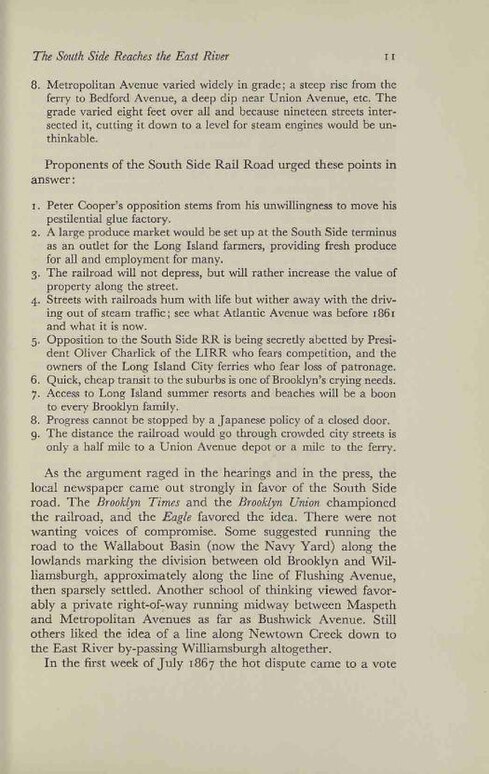8. Metropolitan Avenue varied widely in grade; a steep rise from the ferry to Bedford Avenue, a deep dip near Union Avenue, etc. The grade varied eight feet over all and because nineteen streets intersected it, cutting it down to a level for steam engines would be unthinkable.
Proponents of the South Side Rail Road urged these points in answer:
1. Peter Cooper's opposition stems from his unwillingness to move his pestilential glue factory.
2. A large produce market would be set up at the South Side terminus as an outlet for the Long Island farmers, providing fresh produce for all and employment for many.
3. The railroad will not depress, but will rather increase the value of property along the street.
4. Streets with railroads hum with life but wither away with the driving out of steam traffic; see what Atlantic Avenue was before 1861 and what it is now.
5. Opposition to the South Side RR is being secretly abetted by President Oliver Charlick of the LIRR who fears competition, and the owners of the Long Island City ferries who fear loss of patronage.
6. Quick, cheap transit to the suburbs is one of Brooklyn's crying needs.
7. Access to Long Island summer resorts and beaches will be a boon to every Brooklyn family.
8. Progress cannot be stopped by a Japanese policy of a closed door.
9. The distance the railroad would go through crowded city streets is only a half mile to a Union Avenue depot or a mile to the ferry.
As the argument raged in the hearings and in the press, the local newspaper came out strongly in favor of the South Side road. The Brooklyn Times and the Brooklyn Union championed the railroad, and the Eagle favored the idea. There were not wanting voices of compromise. Some suggested running the road to the Wallabout Basin (now the Navy Yard) along the lowlands marking the division between old Brooklyn and Williamsburgh, approximately along the line of Flushing Avenue, then sparsely settled. Another school of thinking viewed favorably a private right-of-way running midway between Maspeth and Metropolitan Avenues as far as Bushwick Avenue. Still others liked the idea of a line along Newtown Creek down to the East River by-passing Williamsburgh altogether.
In the first week of July 1867 the hot dispute came to a vote
